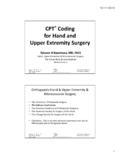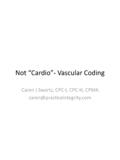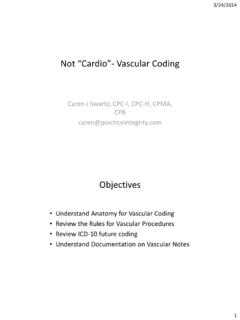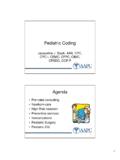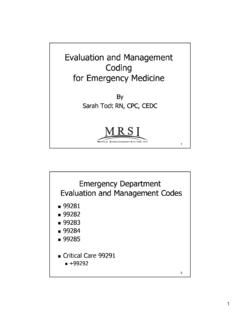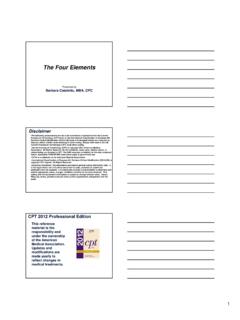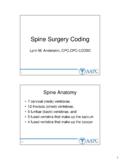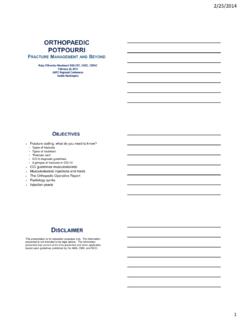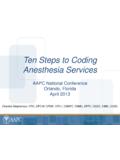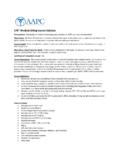Transcription of Coding Secrets in Physical Medicine - AAPC
1 Coding Secrets in Physical Medicine Presented by Evan M. Gwilliam, DC CPC CCPC NCICS CCCPC 1 What will you learn today? 2 to keep payers happy assessment tools to establish medical necessity modality and therapeutic procedure code details References: Medicare Local Coverage Determinations: L29833 (Outpatient Physical Therapy) L24288 (Chiropractic) Introduction BS Accounting - Brigham young University, 2000 DC Palmer College of Chiropractic, 2003 Valedictorian Private practice in Washington and Utah Four Coding certifications ChiroCode Institute - Director of Education, 2012 Target Coding guest speaker / consultant Coding Instructor - Broadview University, Mountainland Applied Technology College Editorial Board Member Master s of Business Administration, Broadview University - 2013 3 Medical Necessity No Medicare payment shall be made for expenses incurred for items or services not reasonable and necessary for the diagnosis or treatment of illness or injury to improve the functioning of a malformed body member Section 1862(a)(1)(A) of the SSA There must be an expectation that the patient s functional status will improve 4 Diagnosis Coding Neurological diagnoses like sciatica ( )
2 Will carry more weight than DDD ( ) or other structural diagnoses Soft tissue such as spasm ( ) or myalgia ( ) are the least significant Documented persistent symptoms, recurrent episodes, severe pain, anomalies, or pathologies can justify double the recovery time 5 Diagnosis Coding Short term (6-12 treatments) 721s Spondylosis 723-724s Back Pain Moderate term (12-18 treatments) 353s Root lesions Unspecified disc disorders 724s Stenosis 846-7s Sprains Long term (18-24 treatments) 722s Degeneration, displaced discs 6 CMS-1500 Claim form 7 Approved for official use 08/05 for official instructions Use all CAPS for the OCR Use 8 digit dates for DOB Don t use punctuation anywhere CMS-1500 Claim form 8 Box 19 local use NUCC qualifiers Additional diagnoses Box 21 diagnoses Follow hierarchy tissue, complicating factors CMS-1500 Claim form 9 Revision 02/12 Changed to match the electronic format (5010) and accomodate ICD-10 codes Adds space for eight more diagnosis codes in box 21.
3 June 1st, 2013 - Health plans and clearinghouses must accept the form. October 1st, 2013 Providers must use the new form Documentation Initial visit should have six elements: (which requires eight elements): oSymptoms causing patient to seek treatment; oFamily history if relevant; oPast health history (general health, prior illness, injuries, or hospitalizations; medications; surgical history); o Mechanism of trauma; oQuality and character of symptoms/problem; oOnset, duration, intensity, frequency, location and radiation of symptoms; oAggravating or relieving factors; and oPrior interventions, treatments, medications, secondary complaints. 10 Documentation 11 Initial visit should have six elements: of present illness including: oMechanism of trauma; oQuality and character of symptoms/problem; oOnset, duration, intensity, frequency, location, and radiation of symptoms; oAggravating or relieving factors; oPrior interventions, treatments, medications, secondary complaints; and oSymptoms causing patient to seek treatment.
4 Documentation 12 Initial visit should have six elements: of musculoskeletal/nervous system through Physical examination 4. Diagnosis: The most severe diagnosis should be listed first Documentation Initial visit should have six elements: Plan: The treatment plan should include the following: oRecommended level of care Acute treatment is shorter duration, higher frequency Chronic treatment is longer duration, but lower frequency Type, amount, duration and frequency of therapy services oSpecific treatment goals; and oObjective measures to evaluate treatment effectiveness 6. Date of the initial treatment 13 Documentation 14 Subsequent visits should have three elements: oReview of chief complaint; oChanges since last visit; oSystem review if relevant. Exam oExam of area of the body involved in diagnosis; oAssessment of change in patient condition since last visit; oEvaluation of treatment effectiveness. 3. Documentation of treatment given Documentation Bad records are: Most common cause of state board action in US Most common reason for claim payment denial Most common source of administrative heartburn Largest source of miscommunication between payers and the providers Documentation Subjective Objective Assessment Plan Only 1/6 of a Problem Oriented Medical Record (POMR) Documentation Problem Oriented Medical Record problem list for each problem goals for each problem treatment plan for each problem notes for ongoing treatment of each problem of resolution or referral for each problem Documentation Complicating factors can increase the time required for recovery symptoms more than 8 days 4 to 7 previous episodes 2X anomaly or structural pathology 2X severe pain 2X superimposed injury 2X Be sure to document these if they are present.
5 Patient Payer Provider Outcome assessment tools (OATs) Blue Cross determines whether services, drugs, supplies or equipment provided by a hospital or other covered provider are: oAppropriate to prevent, diagnose or treat your condition, illness or injury oConsistent with standards of good medical practice in the United States oNot primarily for the personal comfort or convenience of the patient, the family or the provider oNot part of or associated with scholastic education or vocational training of the patient oIn the case of inpatient care, cannot be provided safely on an outpatient basis The fact that one of our covered providers has prescribed, recommended or approved a service or supply does not, in itself, make it medically necessary or covered under this Plan. #m Outcome assessment tools (OATs) Medicare definition of medical necessity under Title XVIII of the Social Security Act, section 1862 (a)(1)(a): Notwithstanding any other provisions of this tile, no payment may be made under Part A or Part B for any expenses incurred for items or services, which are not reasonable and necessary for the diagnosis or treatment of illness or injury or to improve the functioning of a malformed body member.
6 Outcome assessment tools (OATs) Outcomes in clinical practice provide the mechanism by which the health care provider, the patient, the public, and the payer are able to assess the end results of care and its effect upon the health of the patient and society. oYeomans, Steven. (2000) The Clinical Application of Outcome Assessments. Appleton & Lang Outcome assessment tools (OATs) According to Medicare, you must have: complaint* findings plan to get it better** progress** *OATs are traditionally based on #1 only. SONOMA also uses #2 **OATs help to shape and report #3 and #4. Patient Payer Provider Outcome assessment tools (OATs) Outcome assessment tools (OATs) Support medical necessity by quantifying patient functional loss. They objectify the subjective They measure a change in health status after exposure to a health care delivery system. Which is more useful?: o Patient says she feels better OR o Functional outcome assessment score has improved by 30% Functional Status oOswestry oRoland-Morris oNeck Disability Pain Assessment oVisual analog scale oPain drawing oMcGill Pain Questionnaire Outcome assessment tools (OATs) Outcome assessment tools (OATs) What do you do oThe score improves oThe score is unchanged oThe score worsens 30% change is clinically significant (Spine, 2008).
7 What does this mean for the three P s ? Patient Payer Provider Outcome assessment tools (OATs) Procedure Coding Procedure codes are also known as the "what" codes. They fill in box 24, column D of the CMS-1500. "Inclusion of a the CPT codebook is based on whether the procedure is consistent with contemporary medical practice and is performed by many practitioners in clinical practice in multiple locations. Inclusion in the CPT codebook does not represent endorsement by the or imply any health insurance coverage or reimbursement policy." CPT 2012, by the AMA CPT is a registered trademark of the American Medical Association Procedure Coding Physical therapy services are those services provided within the scope of practice of Physical therapists and necessary for the diagnosis and treatment of impairments, functional limitations, disabilities or changes in Physical function and health status. **No -51 on 97001-97755 29 95831 Muscle testing (manual) with report 95851 ROM measurements & report Not time based, but RVUs imply 16-22 minutes Should not be routine Includes a written report, identifying specific body areas and their grades Separate procedure , which means not typically billable with E/M (-25), but could be.
8 Requires written documentation of medical necessity Procedure Coding Procedure Coding 97550 Physical performance test with written report, each 15 minutes Includes functional capacity testing, computerized muscle testing, dynamic gait index, etc. Time to analyze and interpret data is included Document total contact time, time performing the protocol, and time providing post test instructions. Report must include test protocol, data collected, and the impact on the patient outcome/care plan It is atypical to code with E/M or PT eval, but can be done Can t report 98531 or 95851 with 97550 Can be used for SONOMA tool 31 Procedure Coding 97001 & 97002 Physical Therapy Evaluation and Re-evaluation oIncludes history, ROS, Physical assessment, and tests. oReevaluation is necessary only if patient shows significant change oRoutine assessments are not covered typically oBased upon a functional diagnosis, prognosis, and positive prognostic indicators 32 Procedure Coding 97001 documentation should include oTreatment requested oDiagnosis and onset date oMedical history and co-morbidities oSubjective complaint and mechanism of injury oPrior testing, therapy history, and level of function oBaseline evaluation data oReason for skilled care 33 Procedure Coding 97001 treatment plan should include oTreatment strategies oAreas treated oTreatment frequency and duration oPatient home instruction oMeasurable, dated short term goals oMeasurable, dated long term goals oRehabilitation potential oSignature and credentials 34 Defined as any Physical agent applied to produce a therapeutic change to biologic tissue Includes thermal, acoustic, light, mechanical, or electric energy.
9 Two types: in the building attendance- visual, verbal, and/or manual contact with the patient (CPT Assistant, July 2004) **No modifier -51 (multiple procedures) Procedure Coding Modalities CPT is a registered trademark of the American Medical Association Procedure Coding Modalities Usually not indicated as the sole treatment, unless patient cannot tolerate exercise or activities If so, then modalities should not exceed 2-4 treatments Two modalities maximum on each date of service 36 Supervised 97010 hot or cold packs 97012 traction, mechanical 97014 elec stim (unattended) [G0283] 97018 paraffin bath 97022 whirlpool 97024 diathermy 97026 infrared **All say "1 or more areas" **None are time-based CPT is a registered trademark of the American Medical Association Procedure Coding Modalities 97010 hot or cold packs To provide analgesia, relieve muscle spasm, reduce inflammation/edema Cold for acute, heat for subacute/chronic Does not require clinical skill, therefore not considered reasonable and necessary by most payers CPT is a registered trademark of the American Medical Association Procedure Coding Modalities 97012 traction, mechanical Typically cervical or lumbar spine Good for radiculopathy, disc herniation, and sciatica ( )
10 Mutually exclusive to 97140 according to NCCI, but may be billable with -59 Roller tables and VAX-D not covered 3-4 visits maximum CPT is a registered trademark of the American Medical Association Procedure Coding Modalities Supervised - 97012 traction, mechanical Documentation should include: Body part Force applied and angle Time Response of patient Functional progress CPT is a registered trademark of the American Medical Association Procedure Coding Modalities 97014/ G0283 electrical stim, unattended TENS training for pain, 1-2 visits Muscle spasm 2-4 visits without therapeutic procedures Swelling and pain, 6 visits, maybe 12 Muscle retraining up to 12 visits CPT is a registered trademark of the American Medical Association Procedure Coding Modalities Quiz: The provider does e-stim in the lumbar region for twelve minutes, then the left shoulder region for twelve minutes. The correct code(s) would be X2 X2 CPT is a registered trademark of the American Medical Association Procedure Coding Modalities Constant attendance 97032 e-stim (attended) 97033 iontophoresis 97034 contrast baths 97035 ultrasound 97036 Hubbard tank 97039 unlisted modality **All are time based, 1 or more areas.
